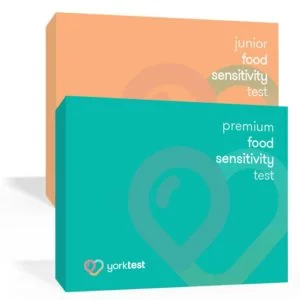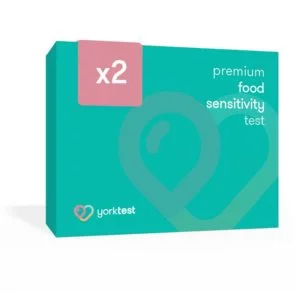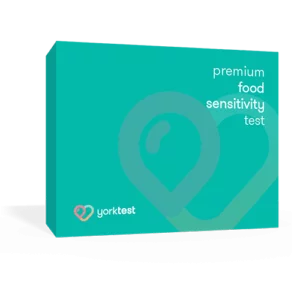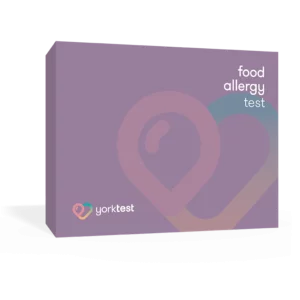- The Sensitivity Problem with Soy
- What Is Soy Allergy vs Intolerance?
- What Are the Signs and Symptoms of a Soy Allergy?
- Soy Intolerance Symptoms
- Does Soy Cause Headaches?
- How Long Do Allergy Symptoms Last?
- Think Youâre Allergic to Soy? Hereâs What to Do
- How to Test for Soy Allergy
- How To Test Soy Allergy In A Baby or Child
- Foods to Avoid with a Soy Intolerance & Sensitivity
- Food Where Soy Is Difficult To Detect
- Get an At-Home Soy Intolerance Test
- References
Soy, also known as soya or soybean, is an agricultural mega-crop that’s been estimated to be used in as much as 60% of manufactured foods. Soy is a common (yet hidden) ingredient found in a wide variety of consumer package products, like processed cereals, crackers, soups, sauces, prepared meats, dairy substitutes, and seasonings. Soy is also frequently used as a vegetable protein filler, emulsifier (soya lecithin), and gluten-free flour for baked goods and starchy processed foods.
While true soy allergy prevalence has not been widely studied, there have been studies conducted that produced some surprising findings. A US study indicates a wider range of soy allergy rates, spanning from 0.1-0.6 percent of the population1. The rates of soy allergy are much higher in young children; a majority of children with a soy allergy will develop an intolerance throughout early childhood. The rates of soya sensitivity are much higher, as it is estimated that general food sensitivities affect around 45% of the population.
While soy allergy rates are generally low compared to other food types, such as tree nuts (which are about 2 times as common in the US), the pervasiveness of soy in food production makes it an ingredient that’s not always easy to detect. In turn, individuals who are sensitive to soy, whether in the form of intolerance or an allergy, should be conscious when consuming processed, store-bought foods.
The Sensitivity Problem with Soy
Like many cases of food intolerance, soy sensitivity can range from mild intolerance to full-blown allergy. At either end of the spectrum, different biological responses can occur in the body. In the case of a true soy allergy or soy sensitivity, an individual’s immune system defenses are triggered, which can cause symptoms to flare.
Soybeans are a member of the legume family, which includes beans, peas, lentils, and peanuts. Although it’s rare for someone with a peanut allergy to react to soy exposure, the reverse has been shown to tell a different story.
One study found that up to 88 percent of individuals that were allergic to soy also had a peanut allergy or were significantly sensitive to peanuts. Additionally, individuals that were allergic to soy were more likely to be allergic or sensitive to other major allergens, including tree nuts, eggs, and cows’ milk.
Soy is one of the “big eight” allergens next to foods like eggs, cows’ milk, fish, shellfish, peanuts, tree nuts, and wheat. These foods account for over 90 percent of all food allergies. In the U.S, the Food and Drug Administration (FDA) requires that food manufacturers and producers mention these foods on packaging and labels to properly warn consumers of such ingredients.
In addition to the sensitivity problem associated with soy-containing foods, soybean production has become widely notorious for using genetically modified organisms (GMOs), raising eyebrows among conscious consumers. GMO soybeans (most commonly produced in the U.S., Brazil, and Argentina) are suspected to have negative long-term effects on the body. Studies observing both non-GMO and genetically modified tofu products (which are predominantly soy-based) indicate that GMO soy can result in adverse effects on the human body that are not immediately felt. However, the effects can arise several years later.
What Is Soy Allergy vs Intolerance?
Many adverse reactions to soy exposure are not considered true allergies. In general, soy allergy is an IgE immune system response that can affect multiple organs of the body.
Conversely, experiencing isolated digestive symptoms or other symptoms like tiredness, skin rashes (soy rash), migraines, headaches, and low mood can indicate a soy intolerance, not an allergy. When a soy-allergic person is exposed to soy, the proteins in the soy bind to specific IgE antibodies produced by the individual’s immune system. This triggers the body’s immune defenses, leading to reaction symptoms ranging from mild to very severe.
With soy intolerance, a common response among those with sensitivity issues is that soy “does not agree†with them. This can manifest as gastrointestinal and digestive problems, such as cramping or diarrhea, headaches, dizziness, nausea, and the other symptoms mentioned above. On the other hand, symptomatic reactions from a soy allergy are often much more intense. They can be rapid and severe, or they may occur gradually within 30 minutes or up to two hours later. With an allergy, the body reacts to soy protein as if it were fighting a disease-producing microorganism. With an intolerance or sensitivity, the immune system can also be triggered. However, the symptoms are delayed, and that’s why the test for soy intolerance or sensitivity is the soya-specific IgG test, not a soya-specific IgE allergy test.
What Are the Signs and Symptoms of a Soy Allergy?
For most individuals with a true soy allergy, the symptoms are generally uncomfortable, but they do pass with time. However, in rare cases, an allergic reaction to soy can be severe and sometimes even life-threatening.
The signs of a soy allergy usually develop within a few minutes after consuming a soy-containing food or drink, but in some cases, the onset can take over an hour or two. The most common soy allergy symptoms can include:
- Oral itching or tingling in the mouth.
- Skin redness, rash, hives, itching sensation, or scaly skin.
- Swelling of the lips, tongue, throat, or other body parts.
- Difficulty breathing, wheezing, or coughing.
- Nasal congestion, runny nose, or sneezing.
- Abdominal pain, diarrhea, nausea, or vomiting.
- Headaches, brain fog, or extreme fatigue.
- Itchy eyes and ear canals.
- Emotional feelings or psychological swings.
In many cases, mixed reactions with multiple different symptoms can occur. In the case of very severe allergic reactions, symptoms of anaphylaxis can manifest, which are extreme and potentially life-threatening. If symptoms of anaphylaxis are present, it’s advised to seek emergency medical attention immediately and use an adrenaline auto-injector if available.
Soy Intolerance Symptoms
The signs of soy sensitivity or intolerance can be slower to present and may cause discomfort. However, they’re generally not life-threatening. Regardless, some of the main soy intolerance symptoms include gas, diarrhea, and abdominal pain.
Does Soy Cause Headaches?
As previously alluded to, soy has the potential to cause headaches as well as other common allergy or intolerance symptoms.
How Long Do Allergy Symptoms Last?
The duration of soy allergy symptoms can vary widely from person to person. Factors like stress and emotional state can contribute to the severity and duration of allergic reactions, as well as things like age, immunity, and other biological conditions.
In general, soy allergy symptoms can last for about 48 hours on average after a reaction begins. However, some soy-allergic individuals have reported their symptoms diminishing within a few hours after onset. In other severe cases, allergy symptoms can linger for several days, or even last upwards of a week.
The longevity of allergy symptoms can also be viewed from a development perspective, such as when an allergy is detectable in children and when allergic reactions dissipate. Because soy allergy is one of several food allergies that commonly begin during the early stages of life, this is a particular topic of interest among parents with soy-allergic children.
Soy allergy usually occurs within the infant and toddler stages before the age of 3. This can include cross-reactive symptoms with other foods, such as cows’ milk and peanuts. Studies indicate that 50 percent of soy-allergic children outgrew their allergy by the age of 7 years, and 69 percent lost allergic symptoms by the age of 10 years.
Think You’re Allergic to Soy? Here’s What to Do
Diagnosing a soy allergy can be as complicated as the symptomatic reactions behind the condition. Because allergy symptoms can vary widely from person to person, an individual may not always experience the same allergic symptoms every time they react. This can make diagnosing a soy allergy (versus a myriad of other potential allergic reactions) a challenge.
If you suspect you’re allergic to soy, such as a soy milk allergy or soy lecithin allergy, it’s important to get tested to determine whether you have a true allergy or a sensitivity intolerance. In either case, you’ll also want to educate yourself about the many common names, ingredients, and forms that soy comes in to avoid triggering symptoms. Here’s a list of various names and forms to watch for:
- Soy (soya, soybean, soyabean)
- Soy-based dairy alternatives (soy cheese, soy ice cream, soy milk)
- Soy protein and soy protein isolate
- Soy lecithin
- Soybean oil
- Hydrolyzed Soy Protein
- Textured Soy Protein
- Textured Soy Flour
- Textured Vegetable Protein
There are also many different types of foods that can be derived from soy but may not contain the word “soy” or “soya” in the name, such as:
- Natural flavors
- Thickening agents
- Stabilizers
- Lecithin
- Xanthan gum and guar gum
- Vegetable oil or shortening
- Vegetable cellulose
- Vegetable starch
- Broth
- Hydrolyzed Plant Protein (HPP) or Hydrolyzed Vegetable Protein (HVP)
Some individuals can tolerate certain processed soy products, such as soy lecithin, without having an allergic reaction. It’s still important to be conscious of these types of ingredients, as some food labels may not indicate “soyâ€, but the food itself may be processed or derived from soy. So, regardless of whether you are exhibiting soy sauce allergy symptoms or reactions to other forms of soy, you are always advised to be cautious.
Because soy intolerance and allergy can vary by person, it can be very helpful to identify the specific ingredients and food types that trigger your symptoms. At the end of this article, we’ll share more soy-based foods, including whole food sources to avoid if you have an allergy or sensitivity to soy.
How to Test for Soy Allergy
When a soy allergy is suspected, it’s recommended to consult an allergist or general physician to determine which allergy test to perform. Alternatively, you can try an at-home-to-laboratory allergy test kit to accurately test whether an allergy exists.
When soy sensitivity is suspected you can also use an at-home soy sensitivity test. At-home tests, which are typically blood tests, provide an accurate way to pinpoint a soy sensitivity.
The way to test for soy sensitivity is using a blood test
- Blood test. As one of the most common methods, particularly for at-home food sensitivity testing, a blood test measures the number of specific antibodies in your bloodstream, known as immunoglobulin G (IgG) antibodies, which can assess your immune system’s intolerance or sensitivity response to soy.
A skin-prick test is used to test for soy allergy, not soy sensitivity. This skin test is more common in a clinical setting, where a medical professional will prick your skin and expose it to small amounts of soy protein. If hives, irritation, or raised bumps break out at the test site on your skin, an allergy can be diagnosed.
When visiting a medical professional for allergy testing, your GP or allergists will likely ask you several questions about the history of your symptoms. If possible, be prepared to answer questions about certain foods you’ve eaten and how much, how long it took for symptoms to develop, what those symptoms were, and how long the symptoms lasted.
How To Test Soy Allergy In A Baby or Child
In short, a blood test is the most common way to test for a soy allergy in babies or children.
Foods to Avoid with a Soy Intolerance & Sensitivity
Soy is found in several types of foods, and in many cases it’s not always easy to detect. Even if you have mild soy intolerance symptoms, it’s good to be aware of the sheer variety of soy-containing foods.
Here is a list of the most common soy-based foods to avoid:
- Soy sauce and shoyu sauce
- Soy-based milk, yogurt, ice cream, or cheese
- Tamari
- Tempeh
- Tofu
- Edamame
- Teriyaki sauce
- Miso
- Natto
- Soy-derived fiber, flour, grits, nuts, or sprouts
- Soy protein, including soy protein isolate
- Textured vegetable protein
Food Where Soy Is Difficult To Detect
Soy is prevalent in many processed and prepared foods, which can make detection less obvious. Here is a list of foods where soy may be found but difficult to detect:
- Bread and starches: crackers, cakes, bread, rolls, or pastries containing peanuts, peanut oil, or soy flour; granola, breakfast bars, and cereals that contain soy ingredients; pasta made with soy flour.
- Vegetables: soybeans, soybean sprouts, and vegetables prepared with sauces or breading that may contain soy ingredients.
- Fruit: drink mixes, sauces, jellies, jams, or fruit toppings that may contain soy products.
- Beverages: soy-based formulas, coffee substitutes, instant coffee, cocoa mixes, malt beverages, soy milk, and fruit drink mixes made with soy ingredients.
- Meat and meat alternatives: sausages and deli meats made with soy, commercial meats with soy-based seasonings or extenders, meat or cheese substitutes made from soy, and textured vegetable protein
- Soups and combination foods: soy is commonly used in many canned soups, commercial entrees, frozen dinners, and combination foods.
- Desserts: soy-containing cakes or cookies, commercial ice creams, frozen desserts, hard candies, nut candies, fudge, and caramels.
- Fats and oils: dairy-free margarine and butter alternatives, soy-containing salad dressings, mayonnaise, sauces, or gravies.
- Condiments: fermented soybean pastes (miso and natto), certain Worcestershire sauces, and other soy-containing sauces like tamari and soy sauce.
Soy can even be found in foods like canned tuna, low-fat peanut butter, and various cooking oils. If you see an ingredient you don’t recognize, be diligent about looking it up and making sure it’s not derived from soy. When in doubt, you can also contact the food manufacturer of a given product if you’re uncertain about its ingredients.
Get an At-Home Soy Intolerance Test
YorkTest makes it easy to test for a soy sensitivity from the convenience of your home. Using a simple finger-prick blood test kit, YorkTest’s Food Sensitivity Test can detect soy intolerance, as well as sensitivity in various other foods. YorkTest is an accredited laboratory that provides accurate, easy-to-read test results.

Rob Wilson, BSC(HONS), HCPC, MIBMS, MBSH
References
1 Messina, Mark PhD, MS; Venter, Carina PhD, RD Recent Surveys on Food Allergy Prevalence, Nutrition Today: 1/2 2020 – Volume 55 – Issue 1 – p 22-29 doi: 10.1097/NT.0000000000000389
2 Savage, Jessica H et al. “The natural history of soy allergy.†The Journal of allergy and clinical immunology vol. 125,3 (2010): 683-6. doi:10.1016/j.jaci.2009.12.994
3 T.Y. Hendrawati, K. Audini, Ismiyati, A.I. Ramadhan, H. Gustia, Effects and characterization of different soybean varieties in yield and organoleptic properties of tofu, Results Eng., 11 (2021) 100238, https://doi.org/10.1016/j.rineng.2021.100238.
4 Kattan, Jacob D et al. “Milk and soy allergy.†Pediatric clinics of North America vol. 58,2 (2011): 407-26, x. doi:10.1016/j.pcl.2011.02.005











